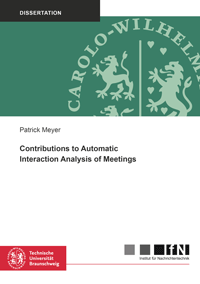
Shop : Details
Shop
Details
58,80 €ISBN 978-3-8440-9670-5Softcover188 pages36 figures259 g21 x 14,8 cmEnglishThesis
October 2024
Patrick Meyer
Contributions to Automatic Interaction Analysis of Meetings
Psychological interaction analyses (IAs) of face-to-face meetings are typically based on a large number of audio and video recordings that must be carefully annotated manually before the actual analysis can start. Since this process is very time-consuming and costly, it limits not only the amount of data that can be taken into account but also the level of detail that can be reached in the analysis. Therefore, the automatic interaction analysis (AIA) of meetings has become a vital research topic, which aims to facilitate psychological interaction studies by developing methods for the automatic processing and analysis of meetings.
For an AIA of meetings based on acoustic data, high-quality audio recordings of each meeting participant are required. This is best achieved by multichannel audio recordings, in which each meeting participant is equipped with a close-talk microphone and recorded in an individual target microphone channel. However, crosstalk is a common problem with such audio recordings and disturbs the speech signals of the participants by each other. As a result, crosstalk significantly complicates the processing of the audio signals and also strongly affects the performance of speech analysis methods for an AIA.
For this purpose, this thesis presents an overall meeting emotion analysis system (OMEAS), which is able to deal with high-level crosstalk. It consists of three methods that in combination reduce the crosstalk in the target microphone signals, detect all utterances of the target speakers, and estimate the emotions of the speakers in each detected utterance. The provided output signals can then be used as basis for further analyses, so that the OMEAS already facilitates and improves the time-consuming annotation process for psychological IAs.
For an AIA of meetings based on acoustic data, high-quality audio recordings of each meeting participant are required. This is best achieved by multichannel audio recordings, in which each meeting participant is equipped with a close-talk microphone and recorded in an individual target microphone channel. However, crosstalk is a common problem with such audio recordings and disturbs the speech signals of the participants by each other. As a result, crosstalk significantly complicates the processing of the audio signals and also strongly affects the performance of speech analysis methods for an AIA.
For this purpose, this thesis presents an overall meeting emotion analysis system (OMEAS), which is able to deal with high-level crosstalk. It consists of three methods that in combination reduce the crosstalk in the target microphone signals, detect all utterances of the target speakers, and estimate the emotions of the speakers in each detected utterance. The provided output signals can then be used as basis for further analyses, so that the OMEAS already facilitates and improves the time-consuming annotation process for psychological IAs.
Keywords: Machine Learning; Audio Signal Processing; Meeting Interaction Analysis
Mitteilungen aus dem Institut für Nachrichtentechnik der Technischen Universität Braunschweig
Edited by Prof. Dr.-Ing. U. Reimers, Prof. Dr.-Ing. T. Kürner, Prof. Dr.-Ing. T. Fingscheidt and Prof. Dr.-Ing. Eduard A. Jorswieck, Braunschweig
Volume 82
Available online documents for this title
You need Adobe Reader, to view these files. Here you will find a little help and information for downloading the PDF files.
Please note that the online documents cannot be printed or edited.
Please also see further information at: Help and Information.
Please also see further information at: Help and Information.
| Document |  | Document | ||
| Type |  | |||
| Costs |  | 44,10 € | ||
| Action |  | Purchase in obligation and download the file | ||
| Document |  | Table of contents | ||
| Type |  | |||
| Costs |  | free | ||
| Action |  | Download the file | ||
User settings for registered online customers (online documents)
You can change your address details here and access documents you have already ordered.
User
Not logged in
Export of bibliographic data
Shaker Verlag GmbH
Am Langen Graben 15a
52353 Düren
Germany
Am Langen Graben 15a
52353 Düren
Germany
Mon. - Thurs. 8:00 a.m. to 4:00 p.m.
Fri. 8:00 a.m. to 3:00 p.m.
Fri. 8:00 a.m. to 3:00 p.m.
Contact us. We will be happy to help you.



